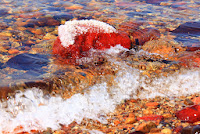 My friend Maitha is getting married. ‘I wanted a small wedding,’
she told me, ‘I was thinking of inviting around 250-300 people…’
My friend Maitha is getting married. ‘I wanted a small wedding,’
she told me, ‘I was thinking of inviting around 250-300 people…’
‘Women?’ I asked.
‘Of course, women…’
The wedding ceremony is a ‘women only’ event
in Emirati culture, with men only appearing at the end, when the groom’s
immediate family bring him onto the stage and place him on the throne, next to
his bride, for the final ceremony. This ceremony is the Aurs (urse), the final
stage before beginning married life.
‘But, my mother said: ”What, my first daughter is getting married
with such a modest affair…? You have become too Westernized!”
‘How many people were you thinking of inviting?’
“Seventeen hundred and fifty,” my mother said.
‘Mum…, you don’t know that many people!’
They settled on eight hundred and fifty.
What about the men? ‘Oh they don’t even have a ceremony sometimes; the
groom’s immediate (male) family will invite a few of his friends and go for a
meal. Then the friends will leave and the father and brothers will take him to
the finale of the women’s ceremony.’ Often though, weddings have male parties
too, although not as large as the women’s and not in the same hall. Men and
women do not celebrate together here.
The bride will spend much of the day getting ready and she will be escorted to her party at 10:30pm, although it will have commenced at around 8pm.
The party sees the women arrive in their black abayas (gowns) and
shelahs (headscarves) but discard them to reveal evening gowns, ornate jewellery
and finely coiffed hair. They keep their scarves close by though, to use when
the groom arrives.
The young girls dress to impress, hoping to find a husband, moving
to the music in front of the stage; there, they can be seen by all the mothers
and sisters.
Maitha: ‘I found a beautiful dress for my cousin’s wedding – I was
really pleased with how I looked in it. But, I came home from work a few days
before the party and my sister was admiring herself in it.
“Hey, I bought that dress to wear myself,” I told her, although she
did look nice in it…
“Oh, you don’t mind if I wear it do you; …you know?” …Yes, she wore
it.’
The men’s party starts at around 6:30pm and often includes traditional
dancing. Most participants leave after the meal, some as early as 9:30, with
only the groom’s close family remaining.
 Engagements are not uncommon here but are falling out of favour. Marriage
commences with a ceremony called Al Melcha. Melcha takes place a month or two
before the (Aurs) wedding party and is where the marriage bond is signed.
Unlike the wedding, this ceremony takes place in the groom’s house, or a hall;
often he has a party with his friends first and once they leave he goes with
his family into a separate room to meet his bride and her family. There they
sign the contract in front of witnesses and a Muslim official.
Engagements are not uncommon here but are falling out of favour. Marriage
commences with a ceremony called Al Melcha. Melcha takes place a month or two
before the (Aurs) wedding party and is where the marriage bond is signed.
Unlike the wedding, this ceremony takes place in the groom’s house, or a hall;
often he has a party with his friends first and once they leave he goes with
his family into a separate room to meet his bride and her family. There they
sign the contract in front of witnesses and a Muslim official.
Once the contract is signed at Melcha, the couple is married, but they
do not move in together and do not consummate their relationship; they do plan
their Aurs though.
The groom’s family generally pays for the wedding and it’s expensive,
although the bride generally chooses the arrangements. One fellow at work paid $10,000
(₤7,000) just for the throne, then there’s wedding jewellery, hall rental, the
party, etc…
 The importance of the Aurs planning must not be underestimated – in
rare cases divorces, so called Melcha-divorces, can result from disagreements over
Aurs arrangements.
The importance of the Aurs planning must not be underestimated – in
rare cases divorces, so called Melcha-divorces, can result from disagreements over
Aurs arrangements.
 The importance of the Aurs planning must not be underestimated – in
rare cases divorces, so called Melcha-divorces, can result from disagreements over
Aurs arrangements.
The importance of the Aurs planning must not be underestimated – in
rare cases divorces, so called Melcha-divorces, can result from disagreements over
Aurs arrangements.
The groom’s father and brothers bring him to join his bride on the
stage at around midnight and then leave; the couple pose for pictures and cut
the cake before leaving for their honeymoon. Finally, in the early hours, the
women’s party ends. Married, at last…
Best wishes to Maitha for a long and happy marriage.
Best wishes to Maitha for a long and happy marriage.
 |
| Sunset on the beach - Ras Al Khaimah |




















